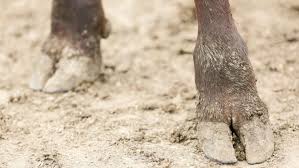Footrot Disease:

The footrot disease is killing the sheep and goats of Gaddi shepherds in Himachal Pradesh.
- Footrot Disease is a highly contagious disease affecting the interdigital (between the toes) tissue of ruminants.
- It is one of the most common causes of lameness in cattle and sheep and can result in serious economic loss.
- Once present in a herd/flock, footrot can be very difficult to control.
- It is caused by the Dichelobacter nodosus bacteria in association with a number of other bacteria.
- Feet infected with D. nodosus serves as the source of infection for other cattle by contaminating the environment.
- Infectious agents gain entry through the skin as a consequence of injury caused by sharp pieces of stone, metal, wood, stubble, or thorns.
- Footrot tends to be seasonal, with the highest incidence occurring during the wet seasons.
- Symptoms: Expression of virulent footrot disease includes:
- chronic and severe lesions
- lameness
- loss of production
- death, in severe cases.
- The interdigital tissue should be cleaned, debrided, and disinfected.
- One antibiotic treatment is usually adequate if administered on the first day of the disease.
- Recovery is generally observed in three to four days.




